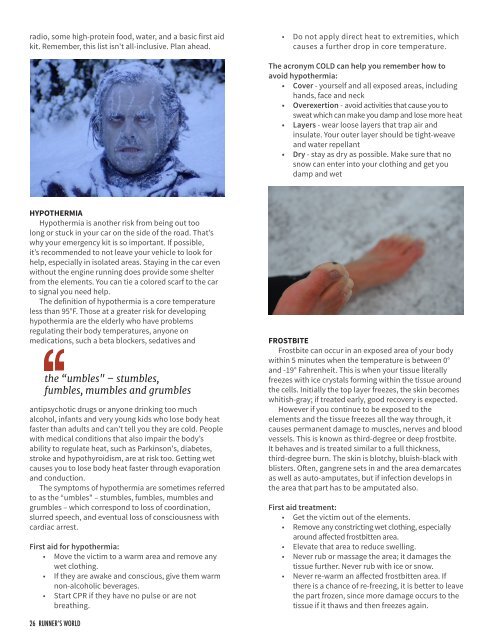Osterman|Creative Multipage Publication
Proposed 2018 Special Edition of Runner's World
Proposed 2018 Special Edition of Runner's World
You also want an ePaper? Increase the reach of your titles
YUMPU automatically turns print PDFs into web optimized ePapers that Google loves.
adio, some high-protein food, water, and a basic first aid<br />
kit. Remember, this list isn't all-inclusive. Plan ahead.<br />
• Do not apply direct heat to extremities, which<br />
causes a further drop in core temperature.<br />
The acronym COLD can help you remember how to<br />
avoid hypothermia:<br />
• Cover - yourself and all exposed areas, including<br />
hands, face and neck<br />
• Overexertion - avoid activities that cause you to<br />
sweat which can make you damp and lose more heat<br />
• Layers - wear loose layers that trap air and<br />
insulate. Your outer layer should be tight-weave<br />
and water repellant<br />
• Dry - stay as dry as possible. Make sure that no<br />
snow can enter into your clothing and get you<br />
damp and wet<br />
HYPOTHERMIA<br />
Hypothermia is another risk from being out too<br />
long or stuck in your car on the side of the road. That’s<br />
why your emergency kit is so important. If possible,<br />
it’s recommended to not leave your vehicle to look for<br />
help, especially in isolated areas. Staying in the car even<br />
without the engine running does provide some shelter<br />
from the elements. You can tie a colored scarf to the car<br />
to signal you need help.<br />
The definition of hypothermia is a core temperature<br />
less than 95°F. Those at a greater risk for developing<br />
hypothermia are the elderly who have problems<br />
regulating their body temperatures, anyone on<br />
medications, such a beta blockers, sedatives and<br />
the “umbles" – stumbles,<br />
fumbles, mumbles and grumbles<br />
antipsychotic drugs or anyone drinking too much<br />
alcohol, infants and very young kids who lose body heat<br />
faster than adults and can’t tell you they are cold. People<br />
with medical conditions that also impair the body’s<br />
ability to regulate heat, such as Parkinson's, diabetes,<br />
stroke and hypothyroidism, are at risk too. Getting wet<br />
causes you to lose body heat faster through evaporation<br />
and conduction.<br />
The symptoms of hypothermia are sometimes referred<br />
to as the “umbles" – stumbles, fumbles, mumbles and<br />
grumbles – which correspond to loss of coordination,<br />
slurred speech, and eventual loss of consciousness with<br />
cardiac arrest.<br />
First aid for hypothermia:<br />
• Move the victim to a warm area and remove any<br />
wet clothing.<br />
• If they are awake and conscious, give them warm<br />
non-alcoholic beverages.<br />
• Start CPR if they have no pulse or are not<br />
breathing.<br />
FROSTBITE<br />
Frostbite can occur in an exposed area of your body<br />
within 5 minutes when the temperature is between 0°<br />
and -19° Fahrenheit. This is when your tissue literally<br />
freezes with ice crystals forming within the tissue around<br />
the cells. Initially the top layer freezes, the skin becomes<br />
whitish-gray; if treated early, good recovery is expected.<br />
However if you continue to be exposed to the<br />
elements and the tissue freezes all the way through, it<br />
causes permanent damage to muscles, nerves and blood<br />
vessels. This is known as third-degree or deep frostbite.<br />
It behaves and is treated similar to a full thickness,<br />
third-degree burn. The skin is blotchy, bluish-black with<br />
blisters. Often, gangrene sets in and the area demarcates<br />
as well as auto-amputates, but if infection develops in<br />
the area that part has to be amputated also.<br />
First aid treatment:<br />
• Get the victim out of the elements.<br />
• Remove any constricting wet clothing, especially<br />
around affected frostbitten area.<br />
• Elevate that area to reduce swelling.<br />
• Never rub or massage the area; it damages the<br />
tissue further. Never rub with ice or snow.<br />
• Never re-warm an affected frostbitten area. If<br />
there is a chance of re-freezing, it is better to leave<br />
the part frozen, since more damage occurs to the<br />
tissue if it thaws and then freezes again.<br />
26 RUNNER’S WORLD


